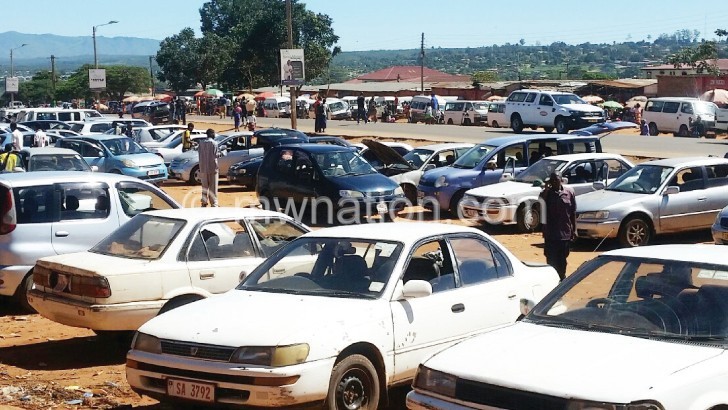A city stuck in traffic jam
Mzuzu is the country’s fastest-growing city, with an annual growth rate of 4.4 percent.
However, it appears the evergreen city’s roads are failing to cope with population boom.
During peak hours, the country’s major transport tarmacs—M1 and M5, which form a ribbon in the city’s central business district (CBD)—are always clogged with motor vehicles scrambling for space with bicycles, motorcycles and pedestrians.
The M1, between Luwinga and Katoto, is a case in point, because of unregulated taxi parking and vending on its edges.
To taxi operator Harry Mughogho, this is a death trap

“It is worse in the evening,” he says. “Traffic is very slow and traffic jams are frequent. Taxis and vendors encroach the shattered shoulders of the two-way road, narrowing it to a single lane. It slows down business as road users increasingly take longer to get to their workplaces, businesses and homes.”
It is survival of the fittest and the lawless operating at their own risk.
“It is extremely risky and accidents will keep happening unless the road is expanded,” says Mughogho.
Lack of designated stops in the city creates chaos and conflicts as minibuses or taxis pick passengers anywhere—anyhow.
Dominic Kamlomo, a lecturer in urban transport planning at Mzuzu University (Mzuni), blames this on lack of mass-transit public transport system
“Most commuters rely on private transport and minibuses which increase traffic volumes on streets, leading to traffic jams and lack of parking space in our cities,” he says.
But the picture is no different in cities of Lilongwe, Blantyre and Zomba.
Kamlomo says non-adherence to planning standards and poor spacing of junctions also delays traffic flow, especially in the absence of side roads.
“On average, there is a junction every 20 metres on the 2.5 kilometre M1stretch between Mzuzu Airport and Chibanja. The standard spacing is one junction for every five hundred metres,” he says.
Amos Kalua, an architect who is studying for a doctorate in urban affairs at Virginia Polytechnic in the US, says there are too many roads feeding into M1 and M5, which are “too narrow” and without any provision for pedestrians, bicycles and pushcarts.
“There are inefficient interconnectedness and dangerous shoulder conditions on the roads of Malawi. Most roads in Mzuzu leave a lot to be desired. It is not uncommon to find deep gullies right in the shoulders. This is responsible for incessant traffic jams and accidents,” he says.
According to the Directorate of Road Traffic and Safety Services (DRTSS), the population of vehicles in the country grows by 12 percent a year.
“The country has 260 155 registered vehicles, excluding those owned by Malawi Police Service, Malawi Defence Force and government vehicles,” says spokesperson Angelina Makwecha.
She reckons the figure is expected to increase in the near future due to high urbanisation, population growth and economic gains.
Mzuzu, Lilongwe, Blantyre and Zomba are home to 16 percent of Malawi’s population estimated at 17.7 million.
Urban employment is projected to rise from 11 percent in 2016 to 15 percent in 2036, exerting pressure on urban transport.
Recently, President Peter Mutharika launched the National Transport Master Plan, which forecasts the demand for private transport to grow by 3.5 percent a year—from 116 000 vehicles in 2016 to 232 000 vehicles in 2036.
The planners expect the demand for public transport to jump by 3.2 percent a year from 261 000 to 490 000 in the same period.
Despite these futuristic projections, paved roads constitute only 26 percent of the 15 451 kilometres classified transport network.
The master plan envisages construction of a dual carriageway from Shoprite Mall to Mzuzu Clock Tower and upgrading the dual carriageway from the Clock Tower to Mzuzu Courthouse decongesting traffic, but government says there is a shortage of funds
According to Minister of Transport and Public Works Jappie Mhango, the dual carriageway will be bankrolled by the African Development Bank.
“We want to decongest our cities of traffic. With such roads, we can manage traffic,” he says.
Mhango claims studies and designs are already complete and the funds for the construction are ready.
For Mzuzu City mayor William Mkandawire, the traffic boom in the city calls for improved roads, including bypasses to decongest the CBD.
“The city is growing, so is the car population. We need roads with multiple lanes. If this isn’t checked now, we will have problems in future,” he says.
But Kamlomo warns that road expansions may consume public space, making it difficult for non-motorised transport and pedestrians if not properly planned.
“Our cities are typified by serious lack of traffic split. Different modes of transportation and pedestrians compete for the same space,” he explains.
The ill impacts include traffic slowdowns, environmental impacts, high consumption of fuel and road accidents, says Kamlomo.
“Traffic management is also crucial for the urban road transport system to work efficiently,” he says.
He wants authorities to intensify road safety awareness campaigns and rigorous enforcement of traffic regulations.





